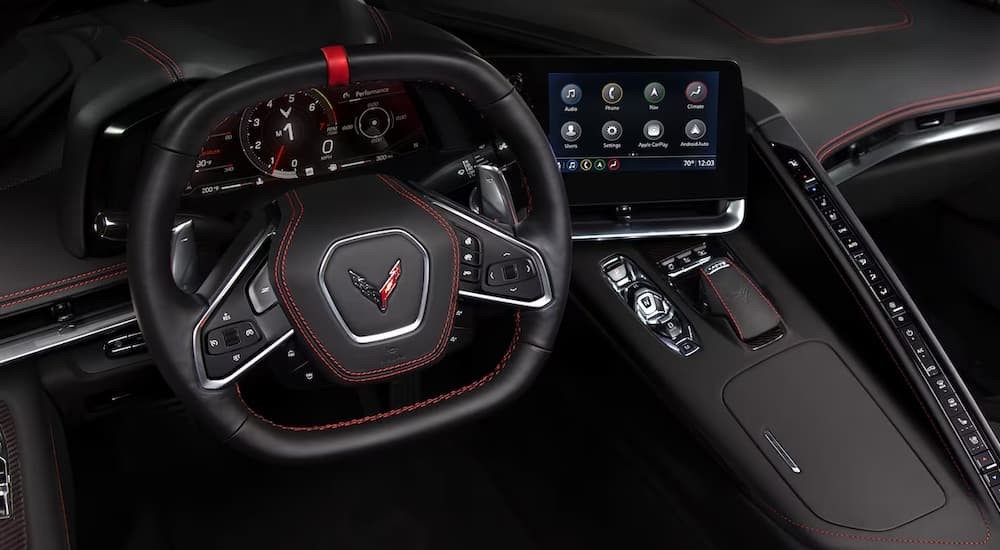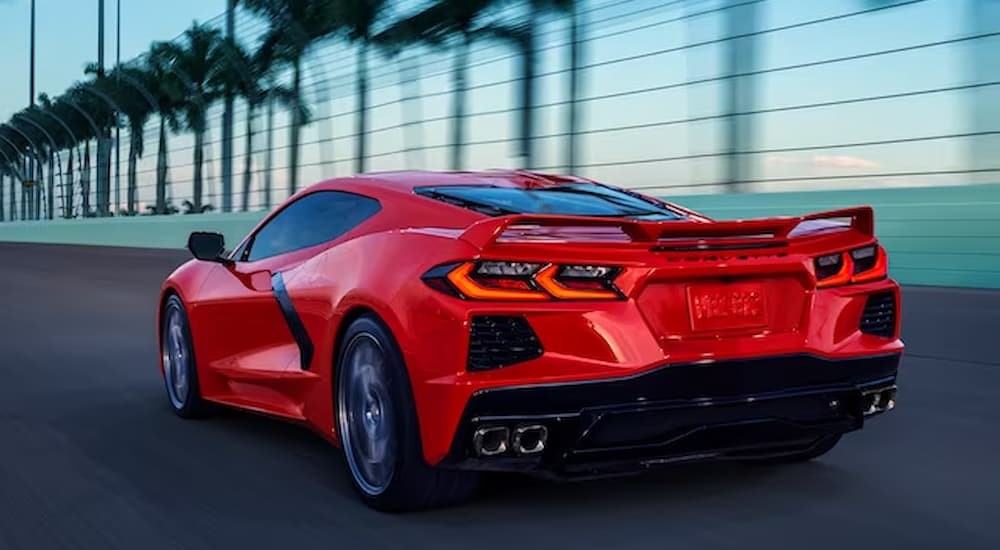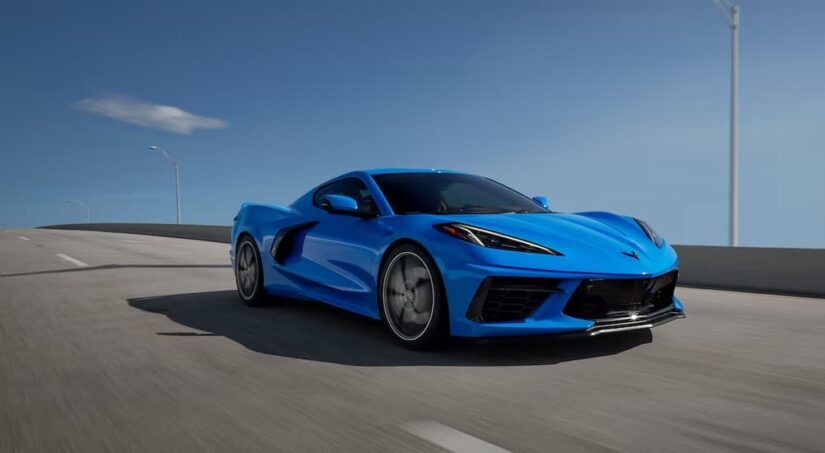Driving doesn’t have to be a chore—it can be a thrilling pastime if you have the right car. Many drivers dream of owning a sports car that performs well and is packed with power, but almost no one has half a million dollars to drop on a Ferrari or Lamborghini. Of course, it’s not an all-or-nothing deal: performance cars come in all shapes and sizes and come with all kinds of price tags too. The Corvette has long been a great choice for drivers who want racecar style and high-end performance for under $100k. But is it still the best deal around?
If you’re considering getting a 2025 Chevy Corvette Stingray and want to know what your other options are, you’ve come to the right place. We’re going to take a look at what the Corvette has to offer, what alternatives exist in its price range, and what you get if you raise or lower your budget to the next bracket. While we’ll be throwing some stats around for the sake of comparison, we’re going to keep things simple so you don’t have to be an enthusiast to understand what we’re saying. There’s a first time for everything, including buying a sports car.
One more note before we dive in: model years on vehicles can be tricky. While calendar years move from one to the next for everyone all at once, model year rollovers are staggered between different automakers and even between different models. Since not all of the information is out yet for 2025 models at time of writing, we will stick to 2024 models for exact details to keep things simple and even the playing field between different models. But if you’re looking at a 2025 Corvette, don’t worry. We expect it to stay in roughly the same price range, and Chevrolet has announced that the new model will only be getting minor changes, such as new exterior and interior color options.
What the Corvette Brings to the Table
With a starting price of $68,300, the Corvette Stingray is certainly an expensive option among cars generally, but for that money, you get all the perks of owning a sports car, from performance to style. The 6.2L V8 engine under the hood can produce up to 490 hp and 470 lb-ft of torque, allowing it to zoom from 0 to 60 mph in as little as 2.8 seconds. Beyond the engine, the car’s chassis, transmission, and suspension are designed to provide both thrilling performance and a comfortable ride.
The exterior makes it clear that this is a car that’s at home on a racetrack, with bold styling cues that don’t just look sleek—they also improve aerodynamics. Inside, the cabin is surprisingly spacious and comfortable for a performance car, making the Corvette capable of doubling as an everyday driving vehicle if you can’t afford to have a dedicated weekend car. The 12.6 cu.ft. of cargo space is plenty for running errands.

Other Performance Options in the Corvette’s Price Range
If you’re looking to spend around $70k on a performance car, there are definitely other options out there, but you’ll be hard-pressed to find something that gives you the same power as the Corvette. For instance, let’s take a look at a brand that has a lot of street cred among driving enthusiasts: Porsche. The Porsche 718 Cayman has a starting price of $72,800 for the base model, which puts it on par with the Corvette. But instead of coming standard with a 490-hp V8, the Porsche has a flat-four base engine that only produces up to 300 hp and 280 lb-ft of torque, getting from 0 to 60 in 4.7 seconds rather than the 2.8 that the Corvette can manage. The Lexus RC F, which has an MSRP of $68,295, does come standard with a V8, capable of producing up to 472 hp and 395 lb-ft of torque. But those figures are still lower than what you’ll find on the Corvette, and the RC F’s 0 to 60 time bears that out: 4.2 seconds.
On the low end of the price range, the Nissan Z NISMO has a starting price of $64,990, but you get what you pay for. Not only does its turbo V6 produce just 420 horsepower and 384 lb-ft of torque, giving it a 0 to 60 time of 3.9 seconds, but it provides way less cargo space than competitors. While the Porsche 718 Cayman and Lexus RC F both provide 10 cu.ft. of cargo space, coming close to the 12.6 cu.ft. in the Corvette, the Nissan offers a mere 6.9 cu.ft.
The BMW M3 has more to offer in terms of performance; its twin-turbo I-6 cranks out 473 hp and 406 lb-ft of torque. But it’s definitely at the high end of the price range. The base model starts at $76,000 and has a 0 to 60 time of 4.1 seconds. You can match the Corvette’s 2.8 second time if you upgrade to the top-tier Competition xDrive trim, but that definitely knocks it up into a new price range thanks to its MSRP of $85,300.
What Can You Get for More Money?
If you’re looking for better performance figures, you can definitely get them, but it’s going to cost you. The legendary Porsche 911 Turbo S boasts a twin-turbo flat-six engine capable of producing up to 640 hp and 590 lb-ft of torque, letting it burst from a stand-still to 60 mph in 2.6 seconds. But that model starts at a staggering $230,400. You’re probably better off sticking with the Corvette family and upgrading to the Z06 instead of the Stingray. The Z06 starts at $112,700 for the 1LZ coupe, and even the top-tier 3LZ Convertible remains under $150k with an MSRP of $126,250. That gets you a more powerful V8 that produces up to 670 hp and 460 lb-ft of torque, allowing the sports car to get from 0 to 60 in 2.6 seconds.

What Do You Lose When You Spend Less?
If $70k sounds too high, there are definitely cars worth looking at in lower price brackets, and many are solid options. The Ford Mustang GT starts at $42,495 and features a capable 5.0L “Coyote” V8 engine that produces 486 horsepower and 418 lb-ft of torque, giving it a respectable 0 to 60 time of 4.2 seconds. The Mazda MX-5 Miata starts at just $28,985, but you’ll feel the difference between its 181-horsepower I-4 engine and its 5.7-second 0 to 60 time. You could spend about the same ($30,900) on a Chevy Camaro instead and get a base V6 engine that makes 335 hp and 284 lb-ft of torque. Come up closer to the Mustang GT’s price, and you can upgrade to the 1SS trim, which starts at $42,300 and comes standard with a V8 that produces 455 hp and 455 lb-ft of torque, allowing it to go from 0 to 60 in 3.9 seconds.
The Corvette Is a Great Value for What You Get
While the average driver may raise their eyebrows at the Corvette’s sticker price, those looking for a high-performance model are able to see the ‘Vette for the bargain it is. As Car and Driver put it, the Corvette has an “insane performance-per-dollar ratio,” outperforming respected foreign models that cost way more. The Corvette Stingray sits alone in the Goldilocks zone, delivering plenty of power at a cost that’s just right. Those looking to go higher or lower can also happily stay in the Chevy family, with the Corvette Z06 offering a more powerful option for more money and the Camaro offering a more affordable alternative that still has respectable stats. The bowtie brand has effectively cornered the market of drivers who want serious performance, but don’t want to be suckered into paying too much for it.



